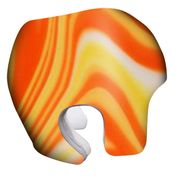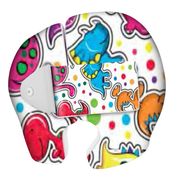Do Cranial Molding Helmets Hurt Babies?
We realize that you may be considering treatment for the condition your baby might have. We also understand that the feelings can be overwhelming because the use of a helmet is probably very new for you!
According to John Hopkins Medicine, molding therapy using a cranial helmet is painless for the infant (John Hopkins Medicine). With a hard outside and thick foam lining inside, these helmets are designed to apply just enough continuous pressure to sculpt the infant’s head while leaving room for the flattened and deformed regions to properly reshape and grow. The helmet also allows for a parent to make adjustments as the child naturally grows.
It can be used to help treat a number of different disorders. One of the main types of conditions is positional plagiocephaly. However, other conditions such as brachycephaly and craniosynostosis are also treated with helmets. (Craniosynostosis requires a helmet in a different way than what would be required for a positional plagiocephaly.)
 Since newborns have skulls that are soft and contain fontanelles (spaces between cranial sutures), an uneven appearance or flat spots may occur. These kinds of helmets are made by medically trained medical professionals and are highly regulated during the manufacturing process. Orthotists provide the helmet but most do not manufacture them because the process is so highly regulated. Only a few places in the United States have received FDA approval to make these helmets but an orthotist would work with them for the fabrication portion of the process. The orthotist would take the initial impression, fit the helmet and then do all the follow up.
Since newborns have skulls that are soft and contain fontanelles (spaces between cranial sutures), an uneven appearance or flat spots may occur. These kinds of helmets are made by medically trained medical professionals and are highly regulated during the manufacturing process. Orthotists provide the helmet but most do not manufacture them because the process is so highly regulated. Only a few places in the United States have received FDA approval to make these helmets but an orthotist would work with them for the fabrication portion of the process. The orthotist would take the initial impression, fit the helmet and then do all the follow up.
Therefore, in short, you can already start to see that this process is taken very seriously and the chances just went down that your child will be hurt in the process.
The child’s head is usually measured prior to putting on a helmet by a certified orthotist. In addition to these measurements, a custom impression is made using a plaster, soft cast and / or a scanning system. After getting the measurements and a custom impression, a larger and more symmetrical helmet is created.
The helmet holds the areas of the head that we do not want to see grow and usually have a hard outer shell with foam lining. There is never any pressure or pain since the helmet allows room for the child to grow into. Thus treating your child’s condition.
 Adjustments to the helmet are also made frequently as the head grows. The helmet does need to be worn all day and can be taken off for bathing. Often times we see that patients wear them for 23 hours per day but this timeline also needs to be stipulated by the patient’s physician. This may seem like a lot, however, it is important to emphasize that the helmet is comfortable.
Adjustments to the helmet are also made frequently as the head grows. The helmet does need to be worn all day and can be taken off for bathing. Often times we see that patients wear them for 23 hours per day but this timeline also needs to be stipulated by the patient’s physician. This may seem like a lot, however, it is important to emphasize that the helmet is comfortable.
Moreover, orthotists throughout the United States and other parts of the world would probably be sued on a routine basis, if not worse, if the helmets were hurting children.
We hope this information helped you. Stay tuned for more information in our blog on cranial remolding helmets.
Good Luck!
